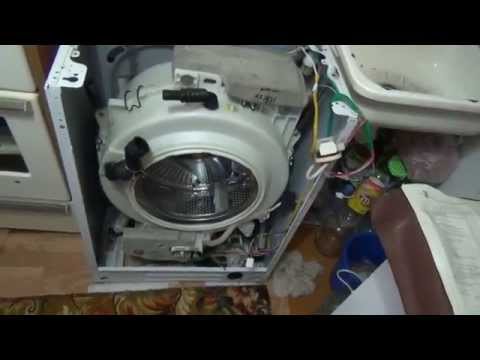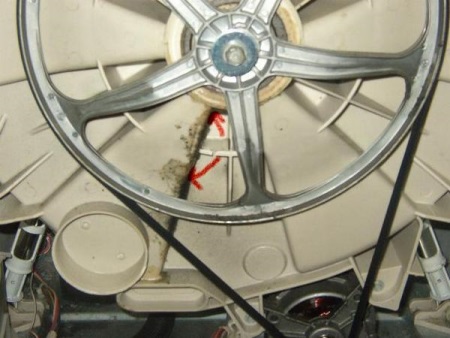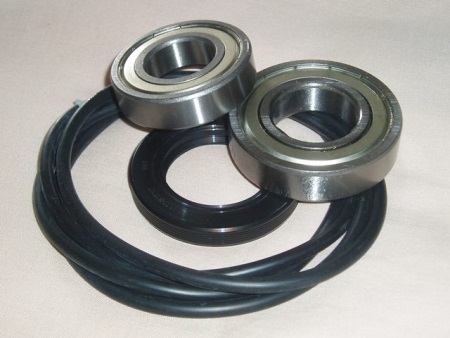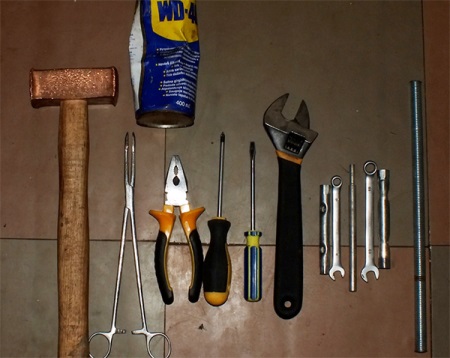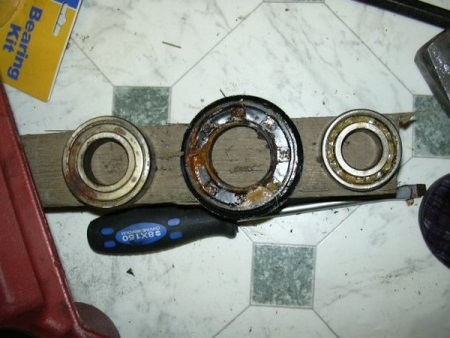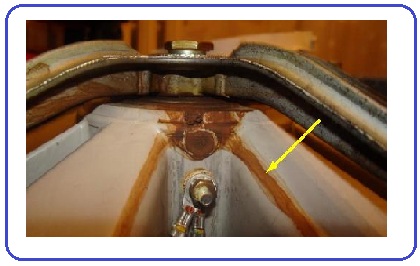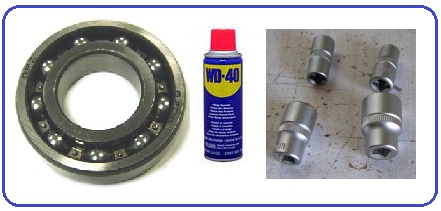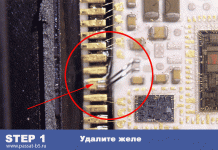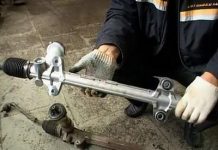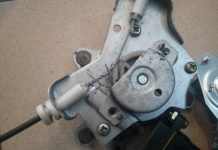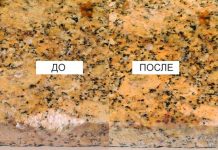In detail: washing machine automatic do-it-yourself repair bearing replacement from a real master for the site my.housecope.com.
The bearing is an important element of the washing machine. It is a metal washer that supports the drum rotation shaft. The bearing helps to evenly distribute the load on the drum, therefore its serviceability is very important for the stable operation of the device. Bearing wear greatly affects the quality of the wash, so it is very important to notice the signs of breakage in time and replace the part.
A characteristic signal indicating that the bearing is defective is the extraneous noise emitted by the washing machine during operation. As soon as you hear an unusual hum or tapping, you need to immediately establish the cause. If it is a bearing, the broken part will have to be replaced.
Read about how to do this without harming the washing machine in our today's article.
To get to the bearing, the washer must be almost completely disassembled.
To do this, you may need the following working tools:
- Screwdriver Set;
- chisel;
- hammer:
- hacksaw;
- pliers and wire cutters;
- set of keys;
- set of hexagons;
- silicone sealant.
Do not forget also about new parts - bearing and oil seals.
- We disconnect the washing machine from the electrical outlet, disconnect the hoses from the water and sewer pipes.
- We move the unit away from the walls, so that there is free access to it from all sides.
- At the back of the washing machine, we find two screws in the upper part and unscrew them. Remove the cover.
- Disconnect the detergent feeder.
- We unscrew the bolt that is located under the feeder.
- Remove the front panel located at the bottom of the device.
- We find two bolts under the panel, unscrew them too.
- We remove two clamps one by one, which fix the rubber cuff on the hatch.
- We pull off the cuff itself from the edge of the hatch.
- We wring out the device that ensures the blocking of the hatch.
- Remove the front panel of the washing machine.
- Remove the back panel of the washing machine.
- Remove the strap from the pulley.
- We disconnect the wires leading to the heating element, having previously photographed their location.
- Disconnect the pipe connecting the pump to the tank.
- We unscrew the two bolts on which the engine is fixed.
- Remove the shock absorbers and springs that hold the tank.
- We carefully take out the tank itself.
| Video (click to play). |
Having pulled out the tank, we determine its appearance. Washing machine tanks are split and non-split. The split tank consists of two halves connected by brackets or bolts. In this case, you just need to remove the fasteners. If the tank is one-piece, we cut it along the weld with a hacksaw for metal.
Next, we act in this order:
- We detach the pulley (wheel) of the drum. We do this using a suitable sized wrench or work with a hammer and chisel.
- We loosen the pulley and carefully remove it from the screw.
- Using the same tools, trying not to damage the shaft, we knock the drum out of the hatch.
- We find bearings on the inner and outer parts of the drum. Moving in a circle, we knock out the worn out bearing from the seat.
- We clean the nest from dirt, treat it with a sealant or special grease.
- We drive a new bearing into the socket and replace the oil seals.
How do you know when a bearing needs to be replaced in a washing machine? In the process of washing the clothes, it begins to make noise, knock, creak. And over time, these unpleasant sounds will only increase. If the bearing is not replaced on time, then it will be much more difficult to do this.Also, if you do not change the bearing in a timely manner, the washing machine may completely break down and will no longer be repairable. The best option, if a bearing breakage is found, is to immediately replace it with a new one.
Replacing the bearing yourself will be very difficult and not at all quick. Therefore, before changing it, you need to decide whether you can do all the necessary work with your own hands? If such work is beyond your strength, then it is better to call a master. Replacing a bearing, including the cost of a new part, will cost you about a third of the cost of a new washing machine. Of course, there are different prices for household appliances and their repairs today, and therefore the cost of repairs given by us is conditional.
So, if you nevertheless decide to carry out the repair yourself, then let's take a closer look at how to do it.
Do-it-yourself washing machine repair begins with the preparation of the necessary tools and spare parts. Remember, the further service life of the automatic machine depends on the quality of spare parts, for this reason, do not buy cheap analogs, give preference to original parts.
So, you will need:
- Hammer
- Open-end wrenches of various sizes
- Pliers
- Metal pin
- Screwdriver Set
- Silicone based sealant
- Water-repellent grease or lithol
- Camera
- 2 bearings
- Stuffing box
In order to be guaranteed to purchase exactly the bearing that you need, the old one must first be removed and an identical one must be selected with it. You may need a camera to make it easier for yourself to assemble a repaired car. Before you disassemble this or that site, take a picture of it and then you will know exactly how to assemble it after repair. When shooting, pay special attention to the wiring connections.
Before replacing a bearing in a washing machine, make sure that normal lubrication will not fix the problem. It often happens that the washing machine begins to rattle from the thinning of the lubricant layer. How to lubricate a bearing in a washing machine? To lubricate this element, it must be freed from the protective caps with a scalpel. Remove the cover carefully. Lubricate the part with a special waterproof lubricant for washing machines. Next, take a new oil seal, also lubricate it and install it. Close the cover. If after these actions the noise is not eliminated, it is necessary to replace the bearing.
See also - How and what to lubricate the oil seal of the washing machine
First you need to remove the cover of the device. This is easy enough. Unscrew the two screws on the rear side panel of the cover and simply lift it up by sliding it back a little.
Next, you need to pull out the detergent tray. Pull the tray towards you and press the release latch while pulling the powder receptacle towards you. These actions should free the tray and it will easily slide out of the grooves. In some models, this button is absent, then you just need to pull the tray, pushing it down a little.
To remove the upper dashboard, you must carefully inspect it. Determine where in your model the bolts for this panel are located, and remove all of them. If after this the panel does not come off easily, then you missed one or more bolts. After the panel cover is unscrewed and easily comes out, you should disconnect all wires from the sockets and completely remove the element. Remember to photograph all parts during the disassembly process. Next, we move on to removing the bottom panel. The process should be straightforward. Using a flat-head screwdriver, press the tabs that hold the bar in place and it will easily release.
The cuff is a special rubber gasket that connects the hatch opening and the laundry drum. It is fastened very simply with a spring and a clamp. To release the cuff and gain access to the removal of the entire front panel, you need to find a clamp.It can be detected visually. To remove it, using a flat screwdriver, pry on the spring and pull out the clamp. Then, carefully detach the cuff from the hatch hole and place it in the drum. Now the part we need is completely free, you can start dismantling it.
Having clicked the door of the washing machine, you need to unscrew the bolts that hold the panel. After that, you must carefully remove it from the hook. Don't pull too hard. The panel is wired to the hatch lock. Don't damage it. As soon as you were able to push this part towards you, disconnect the wire, only then you can fully remove the front wall and free access to the rest of the device.
First you need to get rid of the inner top panel. First of all, you need to inspect the back of the machine and find the screws that secure the water supply valve. After unscrewing these fasteners, you can begin to twist the bolts on the panel. Do not rush to remove it, because you still need to carefully disconnect all the wires and pipes. When everything is disconnected, you can remove the panel itself.
Next, we move on to disconnecting the drain pipe. It is connected to the washing machine tank with a clamp. We unscrew the clamp and disconnect the drain pipe.
After that, we proceed to disconnect the heating element. In different models, it can be located in front or behind the structure. If your tubular electric heater (TEN) is in the back, you will need to remove the back wall. Carefully disconnect all connections to the heating element. Do not forget to photograph the original state before that. At this point, the wiring must be completely disconnected. Please note that in some places it can be fixed to parts of the machine using different fasteners. Having disconnected all the wires, we take them out.
Getting rid of counterweights. This must be done so that the tank is not too heavy. Unscrew them carefully. Then we disconnect the water level sensor. Shock absorbers can be detached. Armed with a wrench, unscrew the bolts holding these parts. It is best to use an extension attachment for these jobs.
Keep in mind that the tank itself is lightweight, so there is no need to make much effort to remove it. Put one hand into the tank and lift it up. With the other hand, release the container from the springs on which it is attached. After that, you can pull it out.
The final step is to remove the belt, unscrew the engine and shock absorbers. When completely empty, the reservoir can be disassembled to replace the bearing.
After the tank is emptied, you may notice that it has two halves. These halves are fastened together along the entire perimeter of the joint. The fasteners depend on the make and model of the washing machine, they can be bolts or special latches. You need to separate the halves. We act depending on the type of fasteners. Removing the front end can often see debris and dirty deposits. It is advisable to get rid of dirt before assembly. On the back half, you will see a drum. It is he who is our goal.
This stage is the most responsible and requires increased attention and caution. We need to carefully detach the drum. First of all, remove the pulley. Simply unscrew the fasteners holding this part and remove the pulley from the axle. After removing the pulley, screw the unscrewed bolt back. At the same time, we spare no effort so as not to spoil the shaft during further work.
We take the hammer. There is no need to be zealous at this stage, proceed with caution. We are trying to gradually knock out the shaft. If these manipulations are in vain and the shaft remains in place, it is better to replace the bolt in order to avoid damage to it. We continue to knock. As soon as the shaft is aligned with the top of the bolt, remove the bolt and pull out the drum.
We proceed to visual inspection of the sleeve and shaft. Often, in case of untimely repairs, these parts can wear out so much that it is necessary to replace the crosspiece.In order to assess the condition of the shaft, it should be wiped with a dry, clean cloth. After that, carefully examine it from all sides for the presence of development. To be completely sure of the integrity of the shaft, put a new bearing on it and determine if there is any play. If you still notice a flaw, without hesitation, change the shaft with a cross.
Next, inspect the bushing. It is located on the shaft and is designed to put on the stuffing box. The bushing should also not show signs of strong wear and mechanical damage. If you find strongly pronounced lateral grooves, such a part will no longer be able to fulfill its functions. An oil seal put on such a bushing will not be able to protect the bearing from water, and repair will need to be done again.
To remove the bearings, you need to remove the oil seal. It is pulled out very simply. Using a flat-blade screwdriver, pry up the oil seal and remove it. Next, we take a metal pin in our hands. With its help, we will knock out these elements. Putting the pin to the bearing, we hit it with a hammer. Then we hit the opposite, the blows should be in the form of a cross, on the four sides of the spare part. With this simple trick, you can knock out both bearings.
With these manipulations, keep in mind that the smaller bearing must be knocked out from the inside, and the larger one outside the tank. Also, when performing these works, be extremely careful not to damage the product. It is best to knock out by resting the part on one knee.
At the end of this step, pay attention to the back wall and the places where the bearings sit. These places should be free of dirt or debris. They should not only be cleaned, they should be polished to a high shine. Only in this case you will not have to repair the car again for a long time.
Well, now it's time to unpack the new bearings. We take the one that is smaller and hammer it in place of the removed one. We also apply the metal pin to the opposite sides, and hammer it in with light hammer blows. In order to determine whether an element has sat down in its place, listen carefully to the sound with the next blow. When the part fits properly, the sound will be more sonorous.
We carry out a similar operation to change the large bearing. Next, we move on to installing a new oil seal. It must be treated with lubricant, only then the oil seal can be put in place. Experts advise using special lubricants developed for washing machines. However, such lubricants are not always available commercially. If you have not found a lubricant, you can use grade 24 lithol. This material is freely sold in car stores.
Now you can be congratulated, the main part of the work is completed. You replaced the necessary element, it's time to put everything back into place. The first step is to lubricate and reinstall the bushing. Next, we connect the halves of the container. To ensure that the tank does not lose its tightness after assembly, it is better to change the O-ring. If you do not have one, treat the abutting edges with silicone sealant and connect the container.
Further, following the photos or just the instructions, we assemble the washing machine in the reverse order.
For many of us today, a washing machine is an integral part of housekeeping. The machine does a significant part of the work for us, giving us comfort and extra minutes of rest. However, in order to prevent your machine from breaking down at the most inopportune moment, it is recommended to carry out timely regular service. This will guarantee a long and trouble-free operation of your machine.
If your bearing in the washing machine buzzes or completely "crumbles", then replacing it is simply necessary so that the machine can continue to function, because as a result, the drum will begin to dangle and subsequently other parts of the machine will deteriorate.If you do not change the bearing in time, then the operation of such a machine can cause such consequences that will force you to change the entire washing machine.
If you decide to replace, then you have two options:
- Calling a repairman and entrusting the job to a professional is the most convenient option, which guarantees you that all the work will be done correctly (subject to the professionalism of the master) and in the shortest possible time. But how much does it cost to change a bearing in a washing machine today? The numbers can actually scare off many, as the cost of repairs can range from 30 to 50% of the cost of a new washing machine.
- If the price of the repair turned out to be high for you, or you think that this work can be done on your own, then this information will be useful for you.
Here we will analyze all the stages of the repair step by step.
Before proceeding directly to the repair of the washing machine, you need to prepare the necessary tools and spare parts that we will change.
From the tool we need:
- Ordinary metal hammer
- Open-end wrench set of different sizes
- Pliers
- Metal rod
- Screwdrivers (Phillips and slotted)
- Silicone sealant.
- Special waterproof grease for bearings of washing machines (in extreme cases, lithol)
- A camera or a phone with a camera - in the process of disassembling the washing machine, we recommend taking photographs of all the parts that you are going to disassemble so that the assembly process is as simple as possible.
Necessary spare parts for repair
Of the spare parts for repair, we need two bearings and an oil seal, which we need to buy. For greater confidence in the correct purchase of spare parts, you can first disassemble the washing machine, remove the old bearings and the oil seal, and then find the originals or analogues on the Internet by the numbers on them. Or find stores that sell spare parts for washing machines, and according to the brand of your machine, they will select the parts you need.
Try to buy original spare parts, they will guarantee you a long service life. Also buy only bearings that are designed for washing machines (they are usually of the sealed type).
Don't want to bother with such a complicated repair of your washing machine? Read the washing machine ratings and choose the best new washing machine for you.
If everything is ready, then you can start disassembling the washing machine.
Remove the top cover
In order to remove it, you need to open two self-tapping screws located on the rear wall of the unit, then slide the cover back and lift it. We remove the removed cover to the side. As you can see, it is very easy to shoot.
Removing the top and bottom panels
After the top cover is removed, we proceed to remove the upper dashboard. But, before you start unscrewing it, remove the powder tray: to do this, pull it out and press the special plastic button while pulling it towards you. Set it aside.
To remove the dashboard, you need to unscrew several self-tapping screws: in different machines there are different numbers and they are in different places, but it is certain that some of the screws are located in the place from which you pulled out the powder receptacle, and another one is located on the right side of the washing machine. Unscrew all of them, then you can remove the top panel.
As you will see, a control board is installed on it, connected by wires that will not allow you to remove it completely. To detach the entire panel, you will need to remove all the chips with wires from the sockets, and then set the top panel aside.
Alternatively, you can not disconnect the wires, but leave the panel hanging, but this is not very convenient and you can accidentally cut off the wiring.
Now we proceed to remove the bottom panel: if you regularly clean the drain valve, then you probably know how to do it, if not, then we will tell you how to do it.To remove the bottom panel, you need to use a screwdriver or other flat object to press on the latches holding it and pull it out.
Removing the cuff
Next, we need to remove the cuff, which prevents us from removing the entire front panel of the washing machine. The cuff is an elastic band that is put on the tank with one end, and on the front panel with the other, and this is all fastened with a clamp, which we need to remove. Run your hand around the perimeter of the elastic and feel for a small spring that connects the ends of the clamp, or find it visually. Next, pry it off with a flat screwdriver and pull it out together with the clamp.
Then remove the front edge of the cuff and tuck it into the tank.
Removing the front panel
Close the door of the washing machine. Locate the bottom and top of the front panel for some self-tapping screws holding it in place. Unscrew them, after which the front panel will be held only by a small special hook. Now remove the front panel, but be very careful as it is wired to the rest of the washing machine.
Once you remove the front panel, disconnect the wire going to the door lock by removing the chip. Then move the panel to the side.
Disconnect all parts from the washing machine tank
Now we need to remove the top panel together with the powder collection box, which is located under the control panel, which we removed earlier. To do this, you need to unscrew the bolts on the back of the washing machine that hold the filler valve, since it will be removed with the panel.
Next, unscrew all the screws holding this panel. Now it can be removed, but pipes and wires interfere with us. Disconnect them and remove this part to the side.
Now we need to disconnect the drain pipe from the washing machine tank, for this we unscrew the clamp and remove it.
Next, we disconnect all the wires suitable for the heating element, it can be located both in front and behind the washing machine, therefore, if necessary, unscrew the back cover.
Also, the wiring can be attached to the tank using cable ties or wire. You need to disconnect it at all points of attachment to the tank. Also, disconnect the wires from the engine, since we will remove it from the outside of the washing machine. If desired, you can disconnect the remaining wiring from the pump and pull it out so that it does not get in the way when you remove the tank.
Now we unscrew the lower and upper counterweights so that they do not add weight to the tank and it would be easier for us to remove it. Counterweights can be located both in front and behind the machine.
We disconnect the pipe going to the water level sensor and you can start unscrewing the shock absorbers of the washing machine. To do this, we find the lower bolts that hold the shock absorbers and unscrew them with a wrench.
Now the tank hangs with us only on springs, and we can remove it, but do it very carefully so as not to drop it. The tank without counterweights is light enough, lift it from the inside with one hand, and with the other, unhook the springs on which it weighs and pull the tank out.
You will remove the tank together with the engine, which must also be unscrewed, but before that remove the belt. Next, we unscrew the engine itself, as well as the shock absorbers that we have left hanging on the tank.
Now we can start disassembling the tank and replacing the bearings in it.
Inspect the bushing and shaft on the drum. If you delayed the repair, then they could wear out and then you will also have to change the crosspiece, which significantly affects the price of repair. In order to check the integrity of the shaft, wipe it well with a rag and see if there is any degradation on it. For more confidence, take new bearings and slide them onto the shaft. After that, check that there is not even the slightest play in the bearing. If there is a backlash, then you need to replace the crosspiece with the shaft.
Also check the bushing, which is on the shaft and on which the oil seal is put on; it should also not have strong wear and transverse grooves.Under the condition of a large output, the oil seal will allow water to pass through and the new bearing will quickly fail.
Having finished with the shaft, we proceed directly to replacing the bearings in the washing machine. They are, as you might have guessed, in the rear wall of the drum and they need to be pulled out from there, but before that, let's remove the oil seal.
To remove the oil seal from the back of the washing machine, take a flat screwdriver and pry it off.
Now we need to knock out both bearings, for this we point a metal rod as thick as a pencil and hit it with sharp, confident movements with a hammer, moving it to different sides of the bearing, cross to cross. Thus, we knock out both bearings.
A small bearing is knocked out from the inside of the tank, a large one, on the contrary, is outside.
After you knocked out the bearings, you need to clean the back cover itself and the bearing seats. Not the slightest dirt should remain in them, and they should simply sparkle with cleanliness.
Now we will take the new bearings out of the packaging. First, we insert a small bearing and also, by guiding the rod, we hammer it, rearranging the rod on different sides of the bearing cross to cross. Hammer the bearing all the way to the stop, when the bearing "sits" in place, the sound from the impact will become more sonorous.
Further in the same way, but on the other side of the tank, hammer in a large bearing.
After that we “stuff” the oil seal with special waterproof grease and insert it into place. You can lightly hammer the oil seal with a hammer similar to the bearing, but be extremely careful not to damage it.
After the bearings and the oil seal are in place, lubricate the bushing on the tank shaft with grease and install it in place, that is, stick it into the back cover.
Now we need to connect the halves of the tank, but before that it is advisable to change the sealing rubber. If this is not possible, then you can simply fill the groove in a circle with a gasket with a small layer of sealant, and then connect the halves of the tank.
Now it remains for us to assemble the washing machine in the reverse order, the photographs that you took during the disassembly process will help you with this. You did them, didn't you?
We recommend that you also watch the video instructions for replacing bearings on a Samsung washing machine, which will help you understand the entire repair process more clearly.
author
Any technique breaks down sooner or later. Washing machines are no exception, the repair of which is quite expensive. And the most common failure of such units is bearing failure. You can save on calling the foreman and take the equipment to the service yourself, but this will require physical effort and time. Home repairs are easier, but the cost increases. In this case, the best option would be to replace the bearing in the washing machine with your own hands. Today we'll talk about how difficult it is to do such a job, and consider the nuances inherent in various brands.
In standard models of automatic machines, 2 bearings are installed - upper and lower. They are located at the rear of the drum and provide uniform, smooth and quiet rotation of the shaft in the seat. For this reason, it is required to closely monitor the technical condition of this unit. Untimely replacement in case of failure can lead to more serious consequences that require expensive repairs or even replacement of the machine.
This is not difficult to understand. The node requires replacement if:
- there are extraneous noises;
- the machine began to vibrate strongly;
- there was a noticeable tapping.
If such "symptoms" occur, a replacement should be performed without delay, in order to avoid more serious consequences and large financial costs.
We will analyze in stages how to replace the bearing of the washing machine drive. The first step is to prepare all the necessary tools, namely:
- a set of screwdrivers (simple and curly), a screwdriver;
- side cutters, pliers;
- a set of wrenches and hexagons;
- puller for bearings of washing machines (can be replaced with a heavy hammer).
It is also necessary to prepare spare parts that will be used for repairs.
This work can be called the simplest. The first step is to remove the side covers, under which are the nodes we need. Next, we turn out the caliper from the side where there is no pulley. The thread here is standard - right-hand. The seat must be cleaned and wiped. The bearing itself is pressed into the plastic base, which means that too much effort is not needed here. It is necessary to ensure that there are no distortions that will lead to leaks and a quick failure of the unit.
Now let's move on to the second bearing. Here you need to remove the drive belt, pulley and grounding bar. Next, we perform the same actions as in the previous version, only the thread is left-handed, which means that it must be unscrewed in the opposite direction - clockwise. Do not forget to lubricate the bearings in the washing machine as thoroughly as possible before installing.
In this case, you have to work. Due to the fact that this lesson is more difficult, we propose to consider step-by-step instructions with photo examples. We will consider the algorithm of work for example, a typewriter of the brand "LG".
After completing all the steps, you can replace the bearings and reassemble everything in the reverse order. If there is no bearing puller, use a hammer. The video below describes in detail how to knock the bearing out of the washing machine drum.
Answering the question of how to change the bearing on the LG washing machine is still half the battle. Indeed, there are structural differences between brands, which means that it would be a big mistake not to consider other well-known brands. To make it easier for the respected reader to understand how this work is done, the Seti.guru editors have collected a short video review on the repair of units from various manufacturers.
Replacing the bearing in Indesit washing machines is simpler than the previous version described by us, as the reader will now be convinced of.
Quite a common brand. But, despite the high build quality, this brand is also prone to bearing wear. We offer a video tutorial on the repair of units from this manufacturer.
Washing machines "Atlant" have long and firmly conquered the market in this segment, although today their popularity has begun to decline. The reason for this is rather tough competition, which is made by cheaper and no less quality brands.
Not only washing machines, but also dishwashers, refrigerators and other household equipment are produced under the Ariston brand. Among the reviews on the Internet, the editorial office of Seti.guru could not find negative ones. All owners are quite happy with the purchase, which indicates the high quality of the equipment.
Despite the high cost of household appliances of this brand, it has not lost its popularity among Russians for many years. As the owners say, Zanussi is equipment you can trust. Let us consider on a video example the algorithm of actions when replacing the bearing of a washing machine of this brand.
The editorial staff of Seti.guru specifically chose shorter and more informative videos to make it easier for the reader to understand the general algorithm of actions. As you can understand in general terms, the actions are similar, there are only minor differences in the work associated with the design features of brands and models.
The cost of replacing a bearing in a washing machine depends on two main factors - the region and the cost of the unit. On average, the cost ranges from 700 rubles. up to 5000 rubles (cost as of April 2018). Many repair firms offer a free home visit of the master, however, you should carefully study the reviews about the company's masters. After all, unscrupulous craftsmen can find many non-existent breakdowns, the repair of which will have to be paid for.And this is a blow to the family budget. Hence the conclusion that the answer to the question of how much it costs to replace a bearing for a washing machine depends on the care of the owner. It is for this reason that the editorial staff of Seti.guru advises to carefully study the information presented today, even if an independent repair is not planned.
Despite the fact that the work on repairing automatic machines is not easy and quite time consuming, if you have free time, it is better to do it yourself. This will save money, and it is not in vain that they said from time immemorial: "If you want to do well, do it yourself." But before you disassemble the bearing, you should soberly assess your strength. Remember that a normal master will not assemble the unit you have disassembled.
Surely you will have to disassemble almost the entire unit.
Replacing a bearing in a washing machine is a major overhaul.
How to verify this malfunction
1.Simply spin the drum by hand and you can hear a noticeable grinding sound. Extraneous noise is the first indicator of a problem.
2. Press on the top of the drum and check for play (shear) from force. There should not be a big backlash between the cuff and the drum.
3. Remove the back of the clipper. Rusty water leaks are another sign.
The average bearing life is 7 years, which will be longer with proper operation and reliable assembly.
Before work, you need to know the dimensions depending on the brand and model. Popular and well-proven companies "SKF" and "Master".
Most of them are steam. They are protected from moisture by an oil seal. So, this oil seal is often the reason for the destruction of the drum assembly.
Water penetrating inside gives corrosion. During the noticed extraneous noise, it will save the shaft, the crosspiece and the tank as a whole. At advanced stages, the repair will be unprofitable.
- The appearance of extraneous noise when the drum rotates
- Washing machine hums during spinning
- Increased wear of the engine drive belt
- Large backlash if you shake the drum with your hand
When dismantling devices, remember how the wires are connected to the heating element, fasteners, connectors. Tools: pipe wrench, screwdrivers, hammer, chisel, sealant, WD, skillful hands)).
The process of replacing the bearings of the collapsible tank:
Take out the stainless steel drum from the tank halves and remove dirt and rust with WD-40. We inspect the condition of the shaft, crosspiece, tank. We treat WD-40 from rust. You can apply zero sandpaper:
This is where the most “interesting” and difficult work of pressing out the old knot begins!
Do not damage the shaft end. Better to use a rubber mallet. Remember to remove the retaining ring.
We dismantle old, destroyed bearings carefully, evenly hitting them with a hammer along the edges.
We install new ones on the seats, after carefully lubricating with a special grease (lithol):
We check the correct fit, spin the drum. Assemble the tank using silicone sealant.
We decide what kind of tank you have.
1.Non-detachable - modern budget models:
WISL 85, WISL 105, WISL 92, WISA 82, WISL 62 (CSI), WISL 82, WISL 83, WISL 103, WIA 80 (CSI), WIA 100, WIA 102 (CSI), WISN 62 (CSI), WIN 62 (CSI), WIN 82 (CSI), WISN 80 (CSI), WISN 100 (CSI), IWB 5083, WIU100 CSI, WIU102CSI, WIU61CSI and others.
2.Dismountable - old models, mechanically operated:
WI 81 EX, WI 101EX, WIL 85EX BG, W 105T X EX and others.
| Video (click to play). |
Background information of oil seals and bearings of the Indesit washing machine
Popular manufacturers: SKF, Rollway, EMS, TSC:

